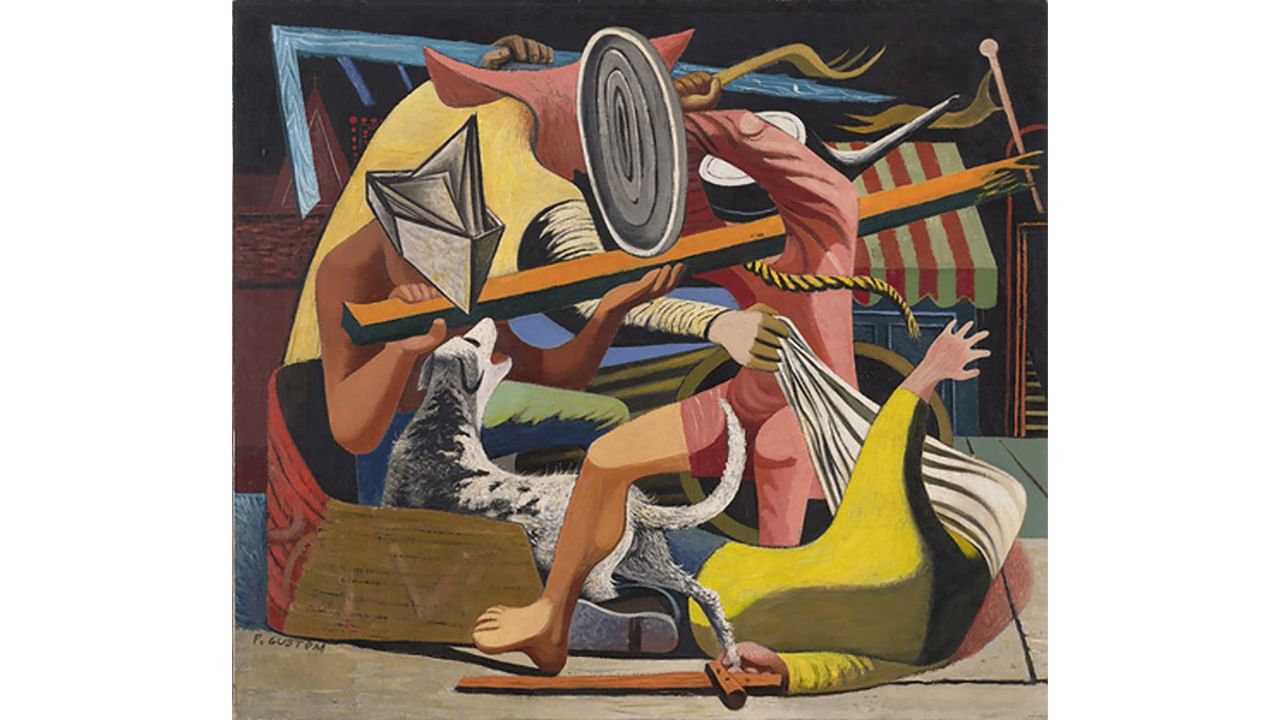
'Entrance'
Philip Guston (1913–1980), considered to be one of America’s finest artists, became known for his brave approach to creating new and surprising imagery both in figurative and abstract modes. By defying conventions and following his artistic intuition, he became a role model to many aspiring young painters as well as cartoonists, writers, poets, and musicians of his country. “Paint true. If you’re disgusted, paint your disgust… But don’t paint to prove an idea. Don’t paint to be loved,” Guston has been quoted as saying.
Guston drew inspiration from the nightmarish world around him and reacted fearlessly against the cruelties and tragedies he witnessed. He constantly pushed himself in new directions while interrogating bigotry and violence.
In the late 1960s, the Vietnam War compelled him to change his entire style of painting. “The war, what was happening to America, the brutality of the world,” he pondered openly. “What kind of man am I, sitting at home, reading magazines, going into a frustrated fury about everything — and then going into my studio to adjust a red to a blue? I thought there must be some way I could do something about it.” In 1975, his grotesque painting ‘San Clemente’ featured the chief protagonist of the Watergate scandal and deposed ex-president Nixon as a bandaged and lamenting cartoonish character.
Historians recall how Guston’s art bridged the personal and the political, the abstract and the figurative, the humorous and the tragic. “Philip was tricky,” observed Pritzker Prize-winning British-Italian architect Richard Rogers. “He was a political animal in one sense, but he was an artist in the truest sense of the word; he had the gift and he understood the value of creative risk.”
Shift to abstraction
Born in Montreal, Canada, in 1913 to Russian-Jewish parents who had fled persecution in Ukraine, Guston grew up in the US and showed an early interest in art. While attending Manual Arts High School in Los Angeles in 1929, he befriended Jackson Pollock (1912–1956). Both Pollock and Guston were expelled from the school for distributing satirical pamphlets. Pollock rejoined the school later; Guston did not.
In the early 1930s, as a young artist, Guston was influenced by several artistic sources including the great Italian quattrocento masters, the early 20th-century works of Giorgio de Chirico, Pablo Picasso, and Pete Mondrian, as well as popular American cartoons. He made politically charged murals which showed his leftist leaning.
In the mid-1930s, he moved to New York at Pollock’s urging. Pollock and Guston were to remain both friends and rivals for a long time.
Pollock began his famous ‘drip’ paintings in 1947. Guston, too, transitioned from symbolic realism into abstraction. By 1950, he had abandoned all figurative or realistic references in his work and become a prominent figure of Abstract Expressionists. He was one of the most celebrated abstract painters of the 1950s and 1960s, alongside Pollock, Mark Rothko and Willem de Kooning.
Back to figuration
Around 1968, Guston drastically changed his style of painting by abandoning abstraction. His bold and brave return to figuration reflected the anxieties of his generation and the social and political upheavals of the late 1960s. His large canvases were now filled with cartoonish figures, empty cityscapes, and everyday objects like books, bricks, and shoes. This new visual vocabulary, in part, highlighted the activities of the dreaded Ku Klux Klan. In comic-style visuals, he ridiculed the Klansmen as eerie figures with triangle hoods and black slit eyes.
When his paintings showing everyday objects and KKK characters were exhibited in New York City in 1970, Guston was immediately and sternly rebuked by critics. He was seen to have betrayed the ideals of the form (abstract expressionism) in which he had made his name. “For a while, I was with no gallery, but that made me feel good,” he would reminisce later. “Freedom is a marvellous thing.” That brave spirit of opting for freedom in the face of criticism shocked and stimulated many younger artists. Guston never called himself a champion of freedom but demonstrated that challenging artistic conventions were an important aspect of his practice. He asserted that all painting was ‘action painting’, one which moves in the mind. “It is not there physically at all. It is an illusion, a piece of magic so that what you see is not what you see.” He liked things rooted in the tangible world; and allowed his art to be nourished by the common and ordinary. “You start your paintings with the most ordinary objects in mind. It could be anything. A briefcase, or a bug crawling across the floor. Then you go on from there.” He believed in the magic of making and allowed symbols in his paintings to collapse on one another. “You’re painting a shoe; you start painting the sole, and it turns into the moon; you start painting the moon, and it turns into a piece of bread.”
Over time, several critics changed their views and acknowledged the power and influence of Guston’s late figurative works grounded in ordinary objects. Peter Schjeldahl, a New Yorker art critic, confessed: “I changed my mind and realised … (that) the job of an artist is not to make you comfortable with your ideals. I’ve since become an enthusiast for the late Guston.”